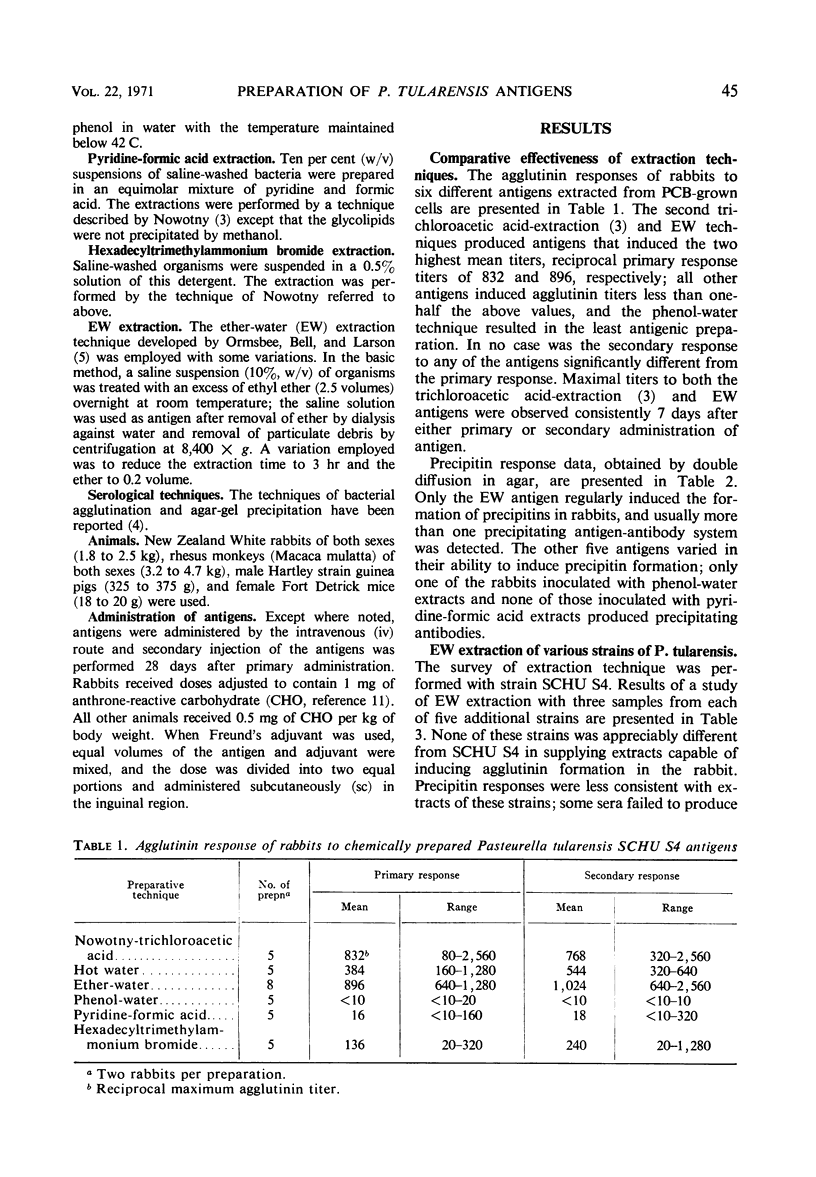Abstract
Ether-water (EW) extraction of Pasteurella tularensis produced better antigens than five other chemical procedures. EW extracts produced from stationary-phase, liquid-grown, saline suspensions of strain SCHU S4 cells regularly induced agglutinin and precipitin formation in rabbits. Mice, guinea pigs, and monkeys also responded to EW extracts but with lower antibody levels. The use of strains of lower virulence, acetone-dried cells, organisms grown on a solid medium, and abbreviated extraction conditions all resulted in extracts with a diminished antigenicity, but logarithmic-phase and stationary-phase cells yielded equivalent EW extracts. The use of adjuvant, hyperimmunization, and large doses of antigen increased the precipitin responses of rabbits without appreciably altering the agglutinin response. By the appropriate combination of centrifugal fractionation of EW extracts, use of adjuvant, and vaccination schedule, rabbit antisera with either predominantly agglutinating or precipitating activities were obtained.
Full text
PDF




Images in this article
Selected References
These references are in PubMed. This may not be the complete list of references from this article.
- ALEXANDER M. M. A quantitative antibody response of man to infection or vaccination with Pasteurella tularensis. J Exp Med. 1950 Jul 1;92(1):51–57. doi: 10.1084/jem.92.1.51. [DOI] [PMC free article] [PubMed] [Google Scholar]
- CARLISLE H. N., HINCHLIFFE V., SASLAW S. Immunodiffusion studies with Pasteurella tularensis antigen-rabbit antibody systems. J Immunol. 1962 Nov;89:638–644. [PubMed] [Google Scholar]
- NOWOTNY A. M., THOMAS S., DURON O. S., NOWOTNY A. Relation of structure to function in bacterial O antigens. I. Isolation methods. J Bacteriol. 1963 Feb;85:418–426. doi: 10.1128/jb.85.2.418-426.1963. [DOI] [PMC free article] [PubMed] [Google Scholar]
- Nutter J. E. Effect of vaccine, route, and schedule on antibody response of rabbits to Pasteurella tularensis. Appl Microbiol. 1969 Mar;17(3):355–359. doi: 10.1128/am.17.3.355-359.1969. [DOI] [PMC free article] [PubMed] [Google Scholar]
- ORMSBEE R. A., BELL J. F., LARSON C. L. Studies on Bacterium tularense antigens. I. The isolation, purification, and biologic activity of antigen preparations from Bacterium tularense. J Immunol. 1955 May;74(5):351–358. [PubMed] [Google Scholar]
- Rodionova I. V., Shipitsina G. K. Immunokhimicheskaia kharakteristika dvukh geograficheskikh raznovidnostei tuliaremiinogo mikroba. Biokhimiia. 1967 Nov-Dec;32(6):1161–1168. [PubMed] [Google Scholar]
- SHEPARD C. C., RIBI E., LARSON C. Electron microscopically revealed structural elements of Bacterium tularense and their in vitro and in vivo role in immunologic reactions. J Immunol. 1955 Jul;75(1):7–14. [PubMed] [Google Scholar]
- TAUBER H., GARSON W. Isolation of lipopolysaccharide endotoxin. J Biol Chem. 1959 Jun;234(6):1391–1393. [PubMed] [Google Scholar]
- TREVELYAN W. E., HARRISON J. S. Studies on yeast metabolism. I. Fractionation and microdetermination of cell carbohydrates. Biochem J. 1952 Jan;50(3):298–303. doi: 10.1042/bj0500298. [DOI] [PMC free article] [PubMed] [Google Scholar]
- WRIGHT G. G., FEINBERG R. J. Hemagglutination by tularemia antisera: further observations on agglutination of polysaccharide-treated erythrocytes and its inhibition by polysaccharide. J Immunol. 1952 Jan;68(1):65–71. [PubMed] [Google Scholar]



